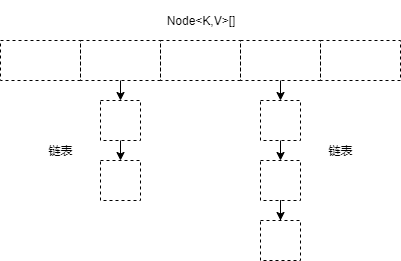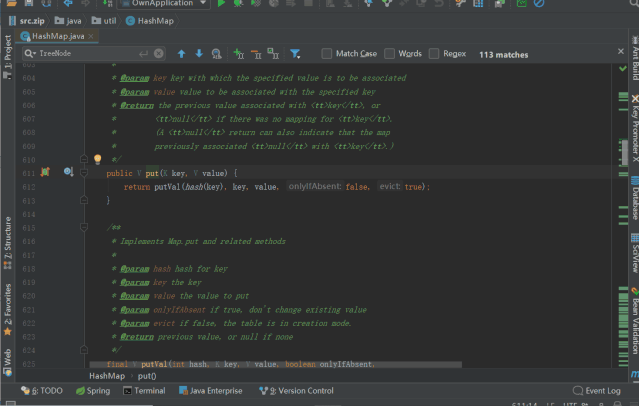《一线大厂Java面试题解析+核心总结学习笔记+最新讲解视频+实战项目源码》,点击传送门,即可获取!
}
/**
* 红黑树结构
*/
static final class TreeNode<K,V> extends LinkedHashMap.Entry<K,V> {
TreeNode<K,V> parent; // red-black tree links
TreeNode<K,V> left;
TreeNode<K,V> right;
TreeNode<K,V> prev; // needed to unlink next upon deletion
boolean red;
…

图片
但面试往往会问的比较细,例如下面的容量问题,我们能答上来几个?
1、table 的初始化时机是什么时候,初始化的 table.length 是多少、阀值(threshold)是多少,实际能容下多少元素
2、什么时候触发扩容,扩容之后的 table.length、阀值各是多少?
3、table 的 length 为什么是 2 的 n 次幂
4、求索引的时候为什么是:h&(length-1),而不是 h&length,更不是 h%length
5、 Map map = new HashMap(1000); 当我们存入多少个元素时会触发map的扩容;Map map1 = new HashMap(10000); 我们存入第 10001个元素时会触发 map1 扩容吗
6、为什么加载因子的默认值是 0.75,并且不推荐我们修改
由于我们平时关注的少,一旦碰上这样的 连击 + 暴击,我们往往不知所措、无从应对;接下来我们看看上面的 6 个问题,是不是真的难到无法理解 ,还是我们不够细心、在自信的自我认为
斗智斗勇,见招拆招
上述的问题,我们如何去找答案 ? 方式有很多种,用的最多的,我想应该是上网查资料、看别人的博客,但我认为最有效、准确的方式是读源码
问题 1:table 的初始化
HashMap 的构造方法有如下 4 种
/**
* 构造方法 1
*
* 通过 指定的 initialCapacity 和 loadFactor 实例化一个空的 HashMap 对象
*/
public HashMap(int initialCapacity, float loadFactor) {
if (initialCapacity < 0)
throw new IllegalArgumentException("Illegal initial capacity: " +
initialCapacity);
if (initialCapacity > MAXIMUM_CAPACITY)
initialCapacity = MAXIMUM_CAPACITY;
if (loadFactor <= 0 || Float.isNaN(loadFactor))
throw new IllegalArgumentException("Illegal load factor: " +
loadFactor);
this.loadFactor = loadFactor;
this.threshold = tableSizeFor(initialCapacity);
}
/**
* 构造方法 2
*
* 通过指定的 initialCapacity 和 默认的 loadFactor(0.75) 实例化一个空的 HashMap 对象
*/
public HashMap(int initialCapacity) {
this(initialCapacity, DEFAULT_LOAD_FACTOR);
}
/**
* 构造方法 3
*
* 通过默认的 initialCapacity 和 默认的 loadFactor(0.75) 实例化一个空的 HashMap 对象
*/
public HashMap() {
this.loadFactor = DEFAULT_LOAD_FACTOR; // all other fields defaulted
}
/**
*
* 构造方法 4
* 通过指定的 Map 对象实例化一个 HashMap 对象
*/
public HashMap(Map<? extends K, ? extends V> m) {
this.loadFactor = DEFAULT_LOAD_FACTOR;
putMapEntries(m, false);
}
构造方式 4 和 构造方式 1 实际应用的不多,构造方式 2 直接调用的 1(底层实现完全一致),构造方式 2 和 构造方式 3 比较常用,而最常用的是构造方式 3;此时我们以构造方式 3 为前提来分析,而构造方式 2 我们则在问题 5 中来分析
使用方式 1 实例化 HashMap 的时候,table 并未进行初始化,那 table 是何时进行初始化的了 ?平时我们是如何使用 HashMap 的,先实例化、然后 put、然后进行其他操作,如下
Map<String,Object> map = new HashMap();
map.put(“name”, “张三”);
map.put(“age”, 21);
// 后续操作
…
既然实例化的时候未进行 table 的初始化,那是不是在 put 的时候初始化的了,我们来确认下

图片
resize() 初始化 table 或 对 table 进行双倍扩容,源码如下(注意看注释)
/**
* Initializes or doubles table size. If null, allocates in
* accord with initial capacity target held in field threshold.
* Otherwise, because we are using power-of-two expansion, the
* elements from each bin must either stay at same index, or move
* with a power of two offset in the new table.
*
* @return the table
*/
final Node<K,V>[] resize() {
Node<K,V>[] oldTab = table; // 第一次 put 的时候,table = null
int oldCap = (oldTab == null) ? 0 : oldTab.length; // oldCap = 0
int oldThr = threshold; // threshold=0, oldThr = 0
int newCap, newThr = 0;
if (oldCap > 0) { // 条件不满足,往下走
if (oldCap >= MAXIMUM_CAPACITY) {
threshold = Integer.MAX_VALUE;
return oldTab;
}
else if ((newCap = oldCap << 1) < MAXIMUM_CAPACITY &&
oldCap >= DEFAULT_INITIAL_CAPACITY)
newThr = oldThr << 1; // double threshold
}
else if (oldThr > 0) // initial capacity was placed in threshold
newCap = oldThr;
else { // zero initial threshold signifies using defaults 走到这里,进行默认初始化
newCap = DEFAULT_INITIAL_CAPACITY; // DEFAULT_INITIAL_CAPACITY = 1 << 4 = 16, newCap = 16;
newThr = (int)(DEFAULT_LOAD_FACTOR * DEFAULT_INITIAL_CAPACITY); // newThr = 0.75 * 16 = 12;
}
if (newThr == 0) { // 条件不满足
float ft = (float)newCap * loadFactor;
newThr = (newCap < MAXIMUM_CAPACITY && ft < (float)MAXIMUM_CAPACITY ?
(int)ft : Integer.MAX_VALUE);
}
threshold = newThr; // threshold = 12; 重置阀值为12
@SuppressWarnings({“rawtypes”,“unchecked”})
Node<K,V>[] newTab = (Node<K,V>[])new Node[newCap]; // 初始化 newTab, length = 16;
table = newTab; // table 初始化完成, length = 16;
if (oldTab != null) { // 此时条件不满足,后续扩容的时候,走此if分支 将数组元素复制到新数组
for (int j = 0; j < oldCap; ++j) {
Node<K,V> e;
if ((e = oldTab[j]) != null) {
oldTab[j] = null;
if (e.next == null)
newTab[e.hash & (newCap - 1)] = e;
else if (e instanceof TreeNode)
((TreeNode<K,V>)e).split(this, newTab, j, oldCap);
else { // preserve order
Node<K,V> loHead = null, loTail = null;
Node<K,V> hiHead = null, hiTail = null;
Node<K,V> next;
do {
next = e.next;
if ((e.hash & oldCap) == 0) {
if (loTail == null)
loHead = e;
else
loTail.next = e;
loTail = e;
}
else {
if (hiTail == null)
hiHead = e;
else
hiTail.next = e;
hiTail = e;
}
} while ((e = next) != null);
if (loTail != null) {
loTail.next = null;
newTab[j] = loHead;
}
if (hiTail != null) {
hiTail.next = null;
newTab[j + oldCap] = hiHead;
}
}
}
}
}
return newTab; // 新数组
}
自此,问题 1 的答案就明了了
table 的初始化时机是什么时候
一般情况下,在第一次 put 的时候,调用 resize 方法进行 table 的初始化(懒初始化,懒加载思想在很多框架中都有应用!)
初始化的 table.length 是多少、阀值(threshold)是多少,实际能容下多少元素
-
默认情况下,table.length = 16; 指定了 initialCapacity 的情况放到问题 5 中分析
-
默认情况下,threshold = 12; 指定了 initialCapacity 的情况放到问题 5 中分析
-
默认情况下,能存放 12 个元素,当存放第 13 个元素后进行扩容
问题 2 :table 的扩容
putVal 源码如下
/**
* Implements Map.put and related methods
*
* @param hash hash for key
* @param key the key
* @param value the value to put
* @param onlyIfAbsent if true, don’t change existing value
* @param evict if false, the table is in creation mode.
* @return previous value, or null if none
*/
final V putVal(int hash, K key, V value, boolean onlyIfAbsent,
boolean evict) {
Node<K,V>[] tab; Node<K,V> p; int n, i;
if ((tab = table) == null || (n = tab.length) == 0)
n = (tab = resize()).length;
if ((p = tab[i = (n - 1) & hash]) == null)
tab[i] = newNode(hash, key, value, null);
else {
Node<K,V> e; K k;
if (p.hash == hash &&
((k = p.key) == key || (key != null && key.equals(k))))
e = p;
else if (p instanceof TreeNode)
e = ((TreeNode<K,V>)p).putTreeVal(this, tab, hash, key, value);
else {
for (int binCount = 0; ; ++binCount) {
if ((e = p.next) == null) {
p.next = newNode(hash, key, value, null);
if (binCount >= TREEIFY_THRESHOLD - 1) // -1 for 1st
treeifyBin(tab, hash);
break;
}
if (e.hash == hash &&
((k = e.key) == key || (key != null && key.equals(k))))
break;
p = e;
}
}
if (e != null) { // existing mapping for key
V oldValue = e.value;
if (!onlyIfAbsent || oldValue == null)
e.value = value;
afterNodeAccess(e);
return oldValue;
}
}
++modCount;
if (++size > threshold) // 当size(已存放元素个数) > thrshold(阀值),进行扩容
resize();
afterNodeInsertion(evict);
return null;
}
还是调用 resize() 进行扩容,但与初始化时不同(注意看注释)
/**
* Initializes or doubles table size. If null, allocates in
* accord with initial capacity target held in field threshold.
* Otherwise, because we are using power-of-two expansion, the
* elements from each bin must either stay at same index, or move
* with a power of two offset in the new table.
*
* @return the table
*/
final Node<K,V>[] resize() {
Node<K,V>[] oldTab = table; // 此时的 table != null,oldTab 指向旧的 table
int oldCap = (oldTab == null) ? 0 : oldTab.length; // oldCap = table.length; 第一次扩容时是 16
int oldThr = threshold; // threshold=12, oldThr = 12;
int newCap, newThr = 0;
if (oldCap > 0) { // 条件满足,走此分支
if (oldCap >= MAXIMUM_CAPACITY) {
threshold = Integer.MAX_VALUE;
return oldTab;
}
else if ((newCap = oldCap << 1) < MAXIMUM_CAPACITY && // oldCap左移一位; newCap = 16 << 1 = 32;
oldCap >= DEFAULT_INITIAL_CAPACITY)
newThr = oldThr << 1; // double threshold // newThr = 12 << 1 = 24;
}
else if (oldThr > 0) // initial capacity was placed in threshold
newCap = oldThr;
else { // zero initial threshold signifies using defaults
newCap = DEFAULT_INITIAL_CAPACITY; // DEFAULT_INITIAL_CAPACITY = 1 << 4 = 16, newCap = 16;
newThr = (int)(DEFAULT_LOAD_FACTOR * DEFAULT_INITIAL_CAPACITY);
}
if (newThr == 0) { // 条件不满足
float ft = (float)newCap * loadFactor;
newThr = (newCap < MAXIMUM_CAPACITY && ft < (float)MAXIMUM_CAPACITY ?
(int)ft : Integer.MAX_VALUE);
}
threshold = newThr; // threshold = newThr = 24; 重置阀值为 24
@SuppressWarnings({“rawtypes”,“unchecked”})
Node<K,V>[] newTab = (Node<K,V>[])new Node[newCap]; // 初始化 newTab, length = 32;
table = newTab; // table 指向 newTab, length = 32;
if (oldTab != null) { // 扩容后,将 oldTab(旧table) 中的元素移到 newTab(新table)中
for (int j = 0; j < oldCap; ++j) {
Node<K,V> e;
if ((e = oldTab[j]) != null) {
oldTab[j] = null;
if (e.next == null)
newTab[e.hash & (newCap - 1)] = e; //
else if (e instanceof TreeNode)
((TreeNode<K,V>)e).split(this, newTab, j, oldCap);
else { // preserve order
Node<K,V> loHead = null, loTail = null;
Node<K,V> hiHead = null, hiTail = null;
Node<K,V> next;
do {
next = e.next;
if ((e.hash & oldCap) == 0) {
if (loTail == null)
loHead = e;
else
loTail.next = e;
loTail = e;
}
else {
if (hiTail == null)
hiHead = e;
else
hiTail.next = e;
hiTail = e;
}
} while ((e = next) != null);
if (loTail != null) {
loTail.next = null;
newTab[j] = loHead;
}
if (hiTail != null) {
hiTail.next = null;
newTab[j + oldCap] = hiHead;
}
}
}
}
}
return newTab;
}
自此,问题 2 的答案也就清晰了
什么时候触发扩容,扩容之后的 table.length、阀值各是多少
-
当 size > threshold 的时候进行扩容
-
扩容之后的 table.length = 旧 table.length * 2,
-
扩容之后的 threshold = 旧 threshold * 2
问题 3、4 :2 的 n 次幂
table 是一个数组,那么如何最快的将元素 e 放入数组 ?当然是找到元素 e 在 table 中对应的位置 index ,然后 table[index] = e; 就好了;如何找到 e 在 table 中的位置了 ?
我们知道只能通过数组下标(索引)操作数组,而数组的下标类型又是 int ,如果 e 是 int 类型,那好说,就直接用 e 来做数组下标(若 e > table.length,则可以 e % table.length 来获取下标),可 key - value 中的 key 类型不一定,所以我们需要一种统一的方式将 key 转换成 int ,最好是一个 key 对应一个唯一的 int (目前还不可能, int有范围限制,对转换方法要求也极高),所以引入了 hash 方法
static final int hash(Object key) {
int h;
return (key == null) ? 0 : (h = key.hashCode()) ^ (h >>> 16); // 这里的处理,有兴趣的可以琢磨下;能够减少碰撞
}
实现 key 到 int 的转换(关于 hash,本文不展开讨论)。拿到了 key 对应的 int h 之后,我们最容易想到的对 value 的 put 和 get 操作也许如下
// put
table[h % table.length] = value;
// get
e = table[h % table.length];
最后
2020年在匆匆忙忙慌慌乱乱中就这么度过了,我们迎来了新一年,互联网的发展如此之快,技术日新月异,更新迭代成为了这个时代的代名词,坚持下来的技术体系会越来越健壮,JVM作为如今是跳槽大厂必备的技能,如果你还没掌握,更别提之后更新的新技术了。

更多JVM面试整理:

《一线大厂Java面试题解析+核心总结学习笔记+最新讲解视频+实战项目源码》,点击传送门,即可获取!
将 key 转换成 int ,最好是一个 key 对应一个唯一的 int (目前还不可能, int有范围限制,对转换方法要求也极高),所以引入了 hash 方法
static final int hash(Object key) {
int h;
return (key == null) ? 0 : (h = key.hashCode()) ^ (h >>> 16); // 这里的处理,有兴趣的可以琢磨下;能够减少碰撞
}
实现 key 到 int 的转换(关于 hash,本文不展开讨论)。拿到了 key 对应的 int h 之后,我们最容易想到的对 value 的 put 和 get 操作也许如下
// put
table[h % table.length] = value;
// get
e = table[h % table.length];
最后
2020年在匆匆忙忙慌慌乱乱中就这么度过了,我们迎来了新一年,互联网的发展如此之快,技术日新月异,更新迭代成为了这个时代的代名词,坚持下来的技术体系会越来越健壮,JVM作为如今是跳槽大厂必备的技能,如果你还没掌握,更别提之后更新的新技术了。
[外链图片转存中…(img-YFtOFgNk-1714642890767)]
更多JVM面试整理:
[外链图片转存中…(img-pxYhXlRH-1714642890768)]
《一线大厂Java面试题解析+核心总结学习笔记+最新讲解视频+实战项目源码》,点击传送门,即可获取!






















 81
81











 被折叠的 条评论
为什么被折叠?
被折叠的 条评论
为什么被折叠?








